Welcome to my new blog which will describe my experience during the final internship experience ! For the summer of 2015, I will be interning at Research Unit for Dietary Studies (EEK) from Parker Institute placed at Frederiksberg Hospital, Copenhagen, Denmark.
Don't wanna be here? Send us removal request.
Text
Future bachelor hypothesis
This will be my last post and will explain with what project I will work for the next 4 months.
For the new project, I will be working with Danish MONICA dataset (http://www.thl.fi/monica/ ). This was a worldwide project where data was collected in order to identify risk factors for cardiovascular diseases. The dataset are quite big and data are still used to be analyzed.
In Denmark, it had started in 1983 and had in total 3608 participants to questionnaires and a detailed health examination. Follow-ups were organized after 2 and 10 years were again they had questionnaires and health examinations. In the end, only 2652 participants have been attending. There wore cases were the participants have died. Moreover, after 30 years (2014) the participants were checked their status (alive or death)through the CPR system.
So, for the bachelor i will analyze the association between BMI, BMI change and waist change AND mortality. This assumed to look like a U shaped association in all the analysis. Further will be examined on family predisposition to obesity and possibly segregated by gender, which is expected now to have somehow a J shape form.
The hypothesis will be that individuals with long lasting obesity or overweight and a family predisposition to obesity are NOT having reduced risk to all-cause mortality.
Can’t wait to learn more about survival analysis in R!
Last reflections about this internship experience
This internship it might be the best thing it happen to me for some time. Not only that I have fulfilled all the learning objectives from my contract, but I have gained valuable experience in the field of epidemiology that only master students, PhD students or post-doc are having. They enabled me to thinking critically and overcome barriers.
I will have to deeply thank everyone in here that supports me and helps me with the process! It was truly a good experience and I hope for many more to come!
6 notes
·
View notes
Text
Last events at my internship place
PhD course on systematic literature search
Last week, I have been attending another PhD short course about literature review. Else Marie Bartels, which by title is PhD (Biophysics), DSc, Research Librarian DB, had enabled us within 3 hours to adequately look for literature. We were advised to use the København Universitetbibliotekets catalog named REX and the København Universitet webpage. Here it can be found webpages that are hosts for databases. There exists different databases relevant for different information that we need to get. More or less everything that we have been taught is on her paper named “ How to perform a systematic search” (http://www.sciencedirect.com/science/article/pii/S1521694213000089 - If you do not have access to this please let me know and I will send you the paper)
Moreover, we have been taught how to use Reference Manager which I am using now for my citations and referencing in my BA thesis.
D-tect meetings
As mentioned before, D-tect (D-tecting diseases) is the project I have been working the past 3 months. I have researched if the margarine consumption during prenatal life affects the development later in life of joint disorders as peripheral arthritis and spinal arthritis.
Recent findings had come to our attentions. It seems that our facts about the starting point of vitamin D fortification are under debate. First of all it seems that margarine was fortified with vitamin A along with vitamin D. It was assumed until now that vitamin D started in 1961 and ended in 1985, where vitamin A wad longer periods of fortification. But this theory come not to be so true, when one of my colleagues had discovered by going through very old books (only paper) and laws from 1925, 1937, 1952 and 1961.
Right now it seems that fortification with vitamin A and D started in 1925 and it seemed not to be compulsory. In 1937 there were more laws regarding the vitamin A and D fortification (advertising, who is in charge of specifying the vitamin A and D quantities, who receives the application etc). Nevertheless, the mandatory fortification was not clearly stated and the quantities were not specified. In 1952, the law of fortification was changed and this time was specified quite specific the regime of fortification (mandatory and quantities). Therefore, my only solution to continue on this path for the BA thesis was to wait until margarine industry will confirm some of the findings and take in consideration just the termination period ( which is clear but the subjects were to young for developing joint disorders) or milk fortification (which was only voluntary for skimmed milk).
These aspects were under discussion for the last 2 weeks at the Research Unit for Dietary Studies. As a conclusion to this, I have decided to go for another project for my BA thesis.
My next post will explain my new BA hypothesis.
3 notes
·
View notes
Text
Academical and professional preparation
Being part of the Research Unit for Dietary Studies from Parker research Institute, I have observed many opportunities of a carrier. But first of all being a Masters graduate student is a minimum requirement. Therefore, the next step to a professional carrier in epidemiology is to continue the studies with a master and PhD. Second of all, I believe that Danish is need it, as many of the meetings are in Danish and the communication with other colleagues will be so much easier and fun.
To be a researcher or an assistant researcher is a beautiful carrier because of its freedom. You could choose projects and hypothesis that actually interest you, you could communicate freely with other specialists and you can have a schedule that is flexible and still be in time for your deadlines. Moreover, is always place for your research and always place for you to grow.
If your research is important enough, other persons can contact you for supervision on their work and maybe collaborations. Which I believe it can be very exciting!
6 notes
·
View notes
Text
What do you need to be a researcher?
Today I opened the tumblr and I was ready to write a post. To be in accordance with school requirements, I opened the guidelines for blogs....The next theme that I supposed to write about it was this “What qualities or characteristics do you see in the people around you? What personality traits, skills, or knowledge are important here? What do you learn about your own style of work and working personality?”. I really not sure what I am supposed to write, but I will describe my colleagues and I believe it is important to know about research.
Being an intern at Parker Institute makes it easy to observe what does it takes to be a researcher or to work in a research unit.
What qualities and characteristics do I see in people around me?
Most of my colleagues are Phd’s,either they completing their Phd here, either they are hired as Phd researchers. There are only 2 interns: Pernille, a bachelor student at Human nutrition at KU, and I. Also, Jing Ding Dong Petersen, former student at Suhr’s, is here by finishing some manuscripts and applying for Phd funding.
Characteristics that I can see in most of colleagues:
- Higher education (master or Phds)
-Advanced epidemiological and bio-statistical knowledge
-Highly interested in others researches
-Very helpful and serious
-Managing their own time frame
-very supportive
I believe the most important skill that you can have here is to have extended knowledge about epidemiology and statistics. It is expected from that you know what epidemiological concepts mean without requiring detailed explanation. Therefore, I will not recommend this kind of internship to someone that had no basic statistics or that is not passionate about epidemiology. It really it takes lots of effort and passion to be a epidemiology researcher.
Another variable that is very vital when you want be a successful researcher is to have lots of connections. In this way you can solve the problems much easier, could receive helpful advices and help and you can promote easier your study.
As a third concern for future researchers I will like to mention FUNDIND. This is one of the most discussed themes in this domain. When you are working in a research institute, is more likely that you and your supervisor have to seek funding. There are also cases that you will work a place where they have all the funding ready for you project, but the cases are rare.
Golden rule of doing research: Stay true to your research!
Bonus: I found a nice article about the golden rules on doing scientific research. So old , so true! https://www.cs.utexas.edu/users/EWD/ewd06xx/EWD637.PDF
About my development as a researcher:
I really developed my working personality and I realized that many things can be done in order to become more professional. One of the things I realized is that is almost impossible to work 8 hours per day, sometimes you just need distractions. For example, now when I am tired, I just blog or searching for literature. Also, a nice or fun article can take out of your tense state.
Link a fun research on arthritis: http://www.ncbi.nlm.nih.gov/pubmed/3625637m
How is it the researchers life?
I believe it is an exciting profession, where you can help individual, scientists and societies knowing the truth about what endangers the health and well being of individuals. Many of the current diseases/conditions could be easily avoided, as ,sometimes, the biggest enemy is the missing information.
Have a good weekend everyone!
6 notes
·
View notes
Text
Fulfilling learning objectives
15-28 of July- I had summer vacation
It appears that the blogging this month was a bit postponed because of the amount of work and the summer vacation.
This post will mention my 4 learning objectives and I will explain how do I fulfill them.
Learning objectives that I expect I will complete this internship.
1. Literature search for the diseases that I will analyze the data
2. Develop my skill on using the statistical program R
3. Analyze data
4. Gain knowledge on statistical tests and epidemiology
Now that I look back on my contract, these are complex and long term objectives that I have and they will probably extend also during next period, when I will write my BA thesis and a scientific paper.
For the moment, I can say that all the learning objectives had been approached and I improved my skills and knowledge.
1. Overview for the first learning objective:
The literature search was build on the relation vitamin D status/supplementation/fortification and the development/prevention of musculoskeletal disorders*. As this disease in regarding a number of disorders, the literature search had been extended for 2 other categories: peripheral disorders*(rheumatic and joint arthritis ) and back disorders*.
Until today, it was completed the search on osteoarthritis (joint arthritis) and started the other disorders. Moreover, a number of scientific papers had been gather in relation of faetus growth, role of vitamin D in bone and cartilage structure, consumption of margarine and milk in Denmark during fortification period etc.
The future plan is to complete the search and register all main resultrs/ideas in excels files, so an overview can be build.
2. Overview for the second learning objective.
As I haven’t use R program for a while (9 months), the development was a bit slowed down in the beginning. But, with a bit of help from my old notes, internet and the statistician, which also use R, I went on the right track and started to run the tests and other commands much faster. This was possible by improving my bio-statistical knowledge as well.
3. Overview of the third learning objective.
The main agreement with my host supervisor was that I will research multiple sclerosis in relation to vitamin D fortification. But, because the waiting time had been extended, we had to review what data they already have available and which diseases that affects the population well-being could be researched. The KRAM data set provides an extended number of individual information, covering as well the age group that we were interested.
The musculoskeletal disorders had been selected, as the Parker Institute (the family of the department where I intern) is the actual research unit for the Department of Rheumatology, Copenhagen University Hospital. Therefore, they could benefit from this scientific paper.
The results have to answer the questions:
a. Is it the exposure to fortified margarine with vitamin D (1961-1985), during fetal life, affecting the development of musculoskeletal disorders later in life? is it for the back disorders and peripheral diseases?
b. Is it there a difference in interaction between genders?
c. What variables are influencing the relationship? And what are the variables that NEED to be the equation?
d. Is there a difference in results for the initiation period ( 1961+/- 5 years) and termination period (1985+/- 5 years)?
e. If we take in consideration also the milk fortification period (1972-1976), what are the results for the 3 types of exposure: non-exposure, exposure to margarine fortification and exposure to both margarine and milk fortification.
With this research question in mind, I had started firstly to analyze the descriptive characteristics of my sample and, further on, to explore the questions. It had been taken a while as linear models included one variable at a time, but this step is completed and awaiting for feedback from my host supervisor.
4. Overview of the forth learning objective.
I am exposed 100% to this professional environment that is dealing every day with epidemiological research. This had raised my awareness towards epidemiology and bio-statistics. I had gained knowledge in more areas that the university teaches me as rheumatology and physiotherapy. Of course this had not been one of the main focuses in the university, but here I could observed that in a developed country this immune-infiltrator disorders are very important for the well-being of the population. Moreover, when it comes to the studies they are also evaluation they scientific development through epidemiological research.
In conclusion, the experience that I am gaining in this institution is more that I could expected ! The collective is great by having supporting colleagues and supervisor, the environment is professional and inspiring and the future is promising! I am very grateful for everything that lead me to this education and internship!
#globalnutritionandhealth#metropolcollegeuniversity#copenhagen#ParkerInstitute#departmentofdietarystudies#frederiksberg#Hospital
6 notes
·
View notes
Text
Week 6-Meeting and meetings
As the previous post was in the middle of the week i still have 2 days from week 5 in which i should let you know what happend.
18 and 19 of June- last 2 days of week 5
Soooo on 18 of June my department had been officially welcomed in the Parker Institute. There have been small presentations: one host by Lars Erik Kristensen from Parker and my supervisor, Berit L. Heitmann. Afterwards, a reception was held to honor the new “marriage”. As well on friday I had a meeting with my supervisor where I had presented her the results on the initiation and termination period. We had agreed to meet on Wednesday with Lars Erik Kristensen which is a specialists in arthritis and other bone disorders, in order to make sure that we have included the appropriate co variables in the logistic regression model. Also, we agreed that I should look for other types of age adjustment methods, just because the current method is not the most appropriate.
Week 6-22-26 of June
Monday, as usual, we had a morning meeting where everyone had shared news, the status, worries and other projects that are included in. It was an opportunity for me to share what issues I have with the statistical analysis and for my colleagues to know me better. (we also had nutella! which made the day perfect :) ). Afterwards, the persons included in D-tect project (including myself) attended a meeting where our statistician, Peder, had demonstrated how an inappropriate age adjustment can destroy the results of the analysis. Him together with few others had developed an adjustment which seems to be relevant for their analysis, but not for me. Anyway, this meeting opened my eyes towards adjustments.
Until Wednesday, when we had the meeting with the arthritis expert, I had looked for better way to adjust for age our model and also considered to do a 3 group analysis: non-exposure, exposure to fortified margarine with vitamin D and exposure to both fortified margarine and milk. The disease of reference is still osteoarthritis(OA). For this factors I would like to analyse if there is statistical difference in the prevalence of OA, which will suggest that fortification with vitamin D of milk and margarine could prevent the development of OA.
Wednesday meeting was very constructive as I gained medical insides of this disease and realized that the definition of the osteoarthritis is to narrow. Therefore, my analysis had expended there will be an analysis which will explore the relationship between exposure to fortified diary products and musculoskeletal disorders and then this one will be separated in 2 categories: peripheral disorders (osteoarthritis and rheumatic arthritis) and axial and spinal disorders. This analysis will be done for all 3 periods: initiation of margarine (1957-1967), the 3 types of exposure( non-exposure ‘57-’60, exposure to margarine ‘61-’71 and milk and margarine ‘72-’76).
This probably will take me few weeks to finish (hopefully before my vacation 15-28 of juli). Meanwhile, age adjustment is still a problem, but soon with a solution!
#GNH Internship2015#PublicHealthNutritionandFoodPolicy#Denmark#ParkerInstitut#ResearchUnitforDietaryStudies
5 notes
·
View notes
Text
Week 4-5 Days-lots of work done
So one moth here, already! Time flies when you have things to do!
As I said in the previous post, this week is the week when I am gone read literature that I found relevant and make an excel table with the results from the studies.
Until now I have 12 papers that are proven to be significant for my literature search:
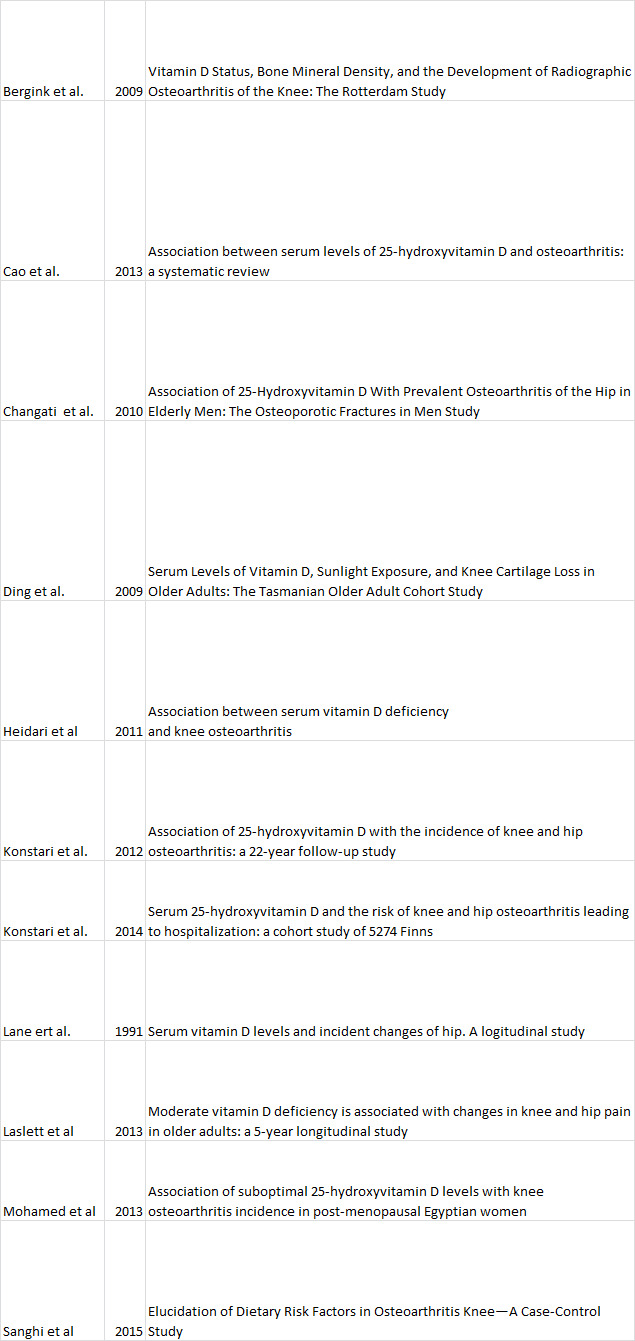
Some of them have found positive results between vitamin D intake and OA, some have found just partial significant resulta as for BMI, vitamin D intake but not supplementation etc; and some of them have found no correlation between vitamin D and OA. There were no studies researching vitamin D intake at prenatal stage and the prevalence of OA. Therefore, my study will elucidate this issue.
On Wednesday, I also started to arrange the data and start analyzing.
The fortification of margarine with vitamin D have started in Denmark on 1st of January 1961 and it was compulsory until 1st of Juen 1985. In the middle, between 1st of January 1972 and 31th of December 1976, the milk fortification was possible but not compulsory. Therefore, my data will be divided i 2 samples. One at initiation, from the earliest case to 1st of January 1972 and one at termination, 1st of January 1977 to latest case. Of course there were some washout and introduction periods which were estimated to be 4 months:1.01.1961-1.05.1961 (introductory) and 1.06.1985-1.10.1985 (washout).
Some of the data changes had to be done in Excel:
Check declared month in the questionnaires with month from CPR nr HVIS(Monthdeclared=Monthspecifies;1;2) - Changes done from 222 subjects
Same for the year -Changes done from 155 subjects
Same for the age - Here everything seemed fine
Data collection: 2008- 5490 subj., 2007-10720 subj., 2006-5530 subj
Delete all the other variables that we are not interested in
Sort after birth date
Make separate data sets for
§ Margarine Initiation-9038 subj
§ Margarine Termination- 4493 subj
§ Milk Initiation- 4391 subj
§ Milk Termination-3819 subj
For all data sets
Make new variable exposure in which N means Non-exposure and E- exposure
Make new variable ISCED 2 (shows SES) and instead of 6 categories we there will be 4
§ 1=1
§ 2=2 &3
§ 3=4 &5
§ 4=6
Make BMI variable from weight and height declared or measured
For s70g (OA), s70h(Osteoporosis) and s70l (Backproblems) there should be done, for each one of it, a separate column which will mark YES for “yes, I have it” or “Yes, I had it” and No for “No I never had it”
For marital status SAMLIV1 there should be a new column stating 1 for being separated/Widow/alone and 2 for being married or being in a partnership.
Physical activity in leisure time should be labeled as P-professional-1, H-high-2, M-Medium-3, L-low-4
Baby weight: if they said the exact number s65b code it according to the list from s65a
Code the s71a as 1 and 2 as Yes AND 3 as No
Make a new column for s72g which will have Yes if s72g1 or s72g2 is 1 AND No if s72g3 is 2 (Same for s72f)
Put hours oh sun light during pre-natal life
Make one variable “Painkillers” which will bring together the answers from s72f and s72g: that will mean that subjects with Yes had taken any kind of painkillers in the last 14 days.
And other in R: as changing the numbers to factors etc.
The first step in analyzing the data is to make the descriptive characteristics of your population and test for significant differences between the 2 groups: exposure and non-exposure.
For the analysis of the data there will be used the generalized linear model-binomial (logistic). And I have decided to use it for 9 models:
a. Crude model
b. Model adjusted for age
c. Model adjusted for age and gender
d. Model adjusted for age, gender and education
e. Model adjusted for age, gender, education and hours of sun during pre-natal life
f. Model adjusted for age, gender, education, hours of sun during pre-natal life and birth weight
g. Model adjusted for age, gender, education, hours of sun during pre-natal life, birth weight and BMI
h. Model adjusted for age, education, hours of sun during pre-natal life, birth weight, BMI and pain experienced in last 14 days, pain killers taken the last 14 days.
i. model adjusted for age, education, hours of sun during pre-natal life, birth weight, BMI , pain experienced in last 14 days, pain killers taken the last 14 days and physical activity during leisure time .
Moreover, a difference of the effect between genders could be seen, therefore I had to segregated between sexes and run the models again. Marie and Louise suggested to separate the effect for months and seasons. In this way, we will able to see if the vitamin D fortification should be done for some periods.
Next week:Finish the analysis and have a meeting with the supervisor.
#GHN#PublicHealthNutrition&FoodPolicy#Denmark#frederiksberg#Hospital#ParkerInstitute#EEK#ResearchUnitforDietaryStudies
6 notes
·
View notes
Photo
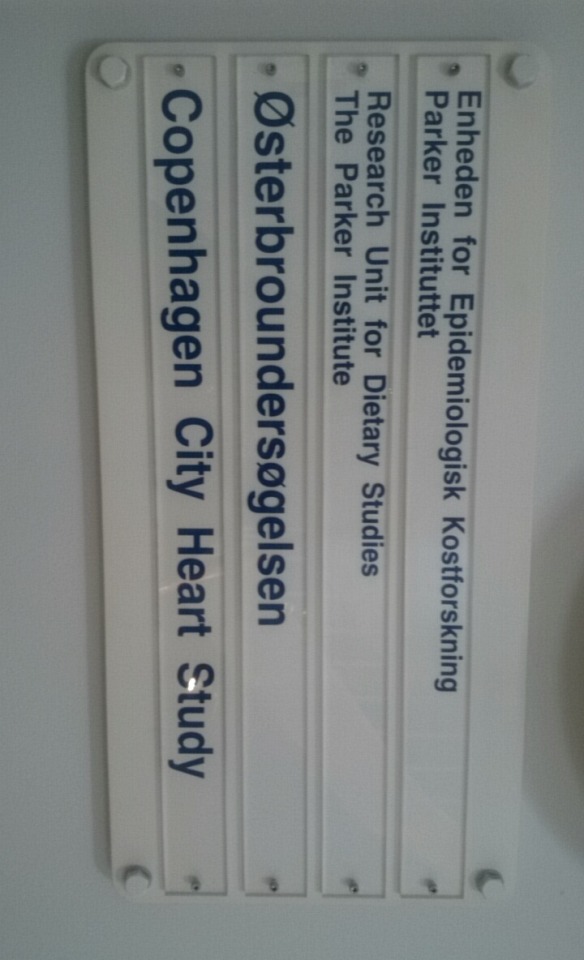
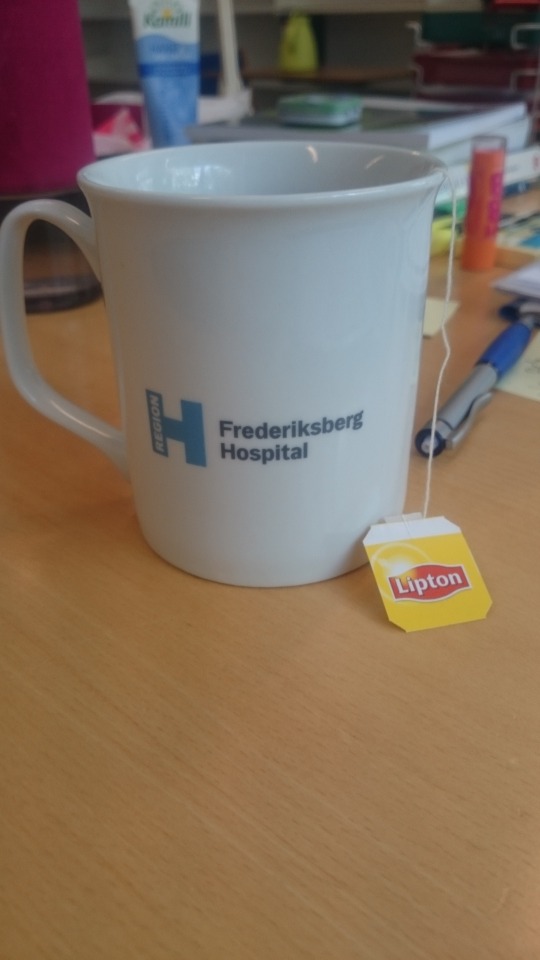
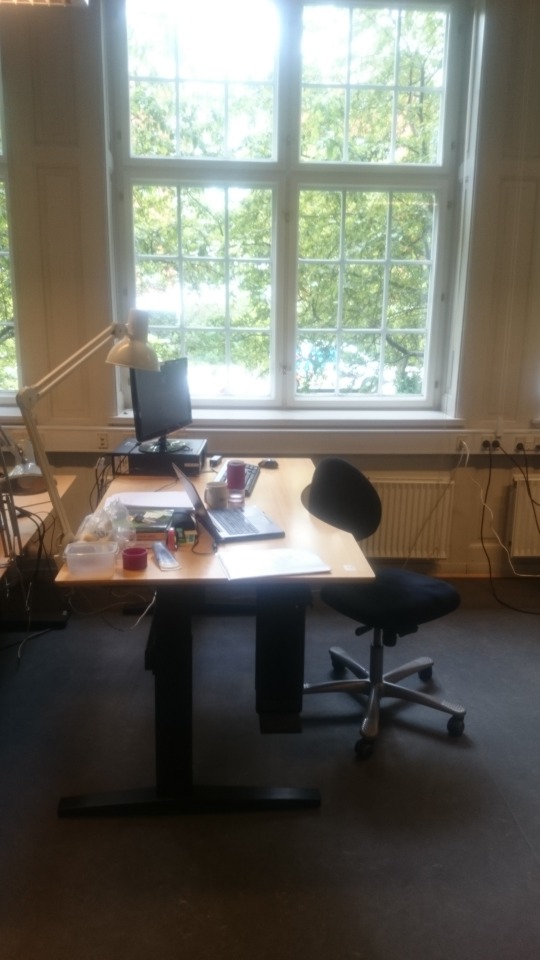
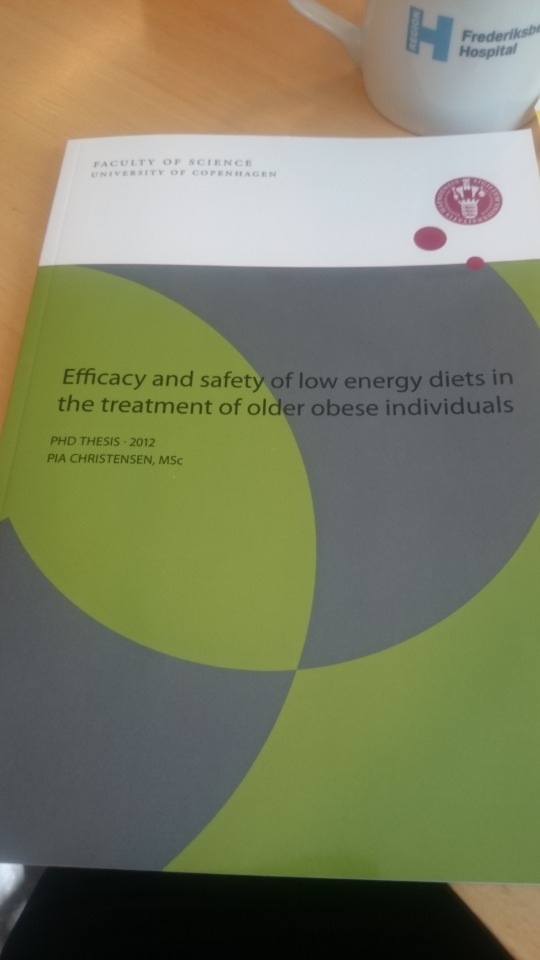

Some pictures where it illustrates the office where I am placed
6 notes
·
View notes
Text
Second and third week- When time flyes
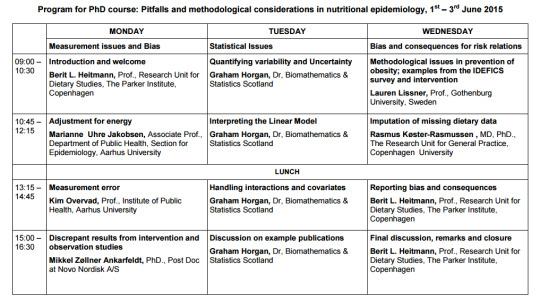
The next two weeks of my internship had been shorter due to the national holidays: 25th of May and 5th of June.
25-29 of May
Second week was one full of meetings and getting use to the working environment. We have meetings each monday at 10 o clock just for my department and we have breakfast together and we discuss different issues that we come across.
Tuesday we have a meeting at 8:15 at Parker Institute where different persons present their results, poster with results and papers. Depending on the specialization of that researchers might relevant or less relevant to me, but all becomes interesting when you start analyse the way the persons presents. It clearly develops my knowledge and skills.
Friday at 9:00, there is another meeting where we eat some breakfast and each persons tells the updates of the week. It keeps you being on time with the tasks!
In the second week we also had 2 extra meeting. The first one was on Wednesday, where my new colleague, JingDing, and I had went to Parker Institute building and had been instructed by Else what literature databases to use and how to use it. For my literature search I was instructed to use the Medline available on Pubmed and Embase available on Ovid.Moreover, she show us where to look for different information as economic, sociological related. Moreover, we have been instructed how to find terms that signify the same condition/ vitamin etc. just to increase our chances to find the proper literature. Further, we had a small tour and it ended with a visit to the administrator, Claus Bomhoff. He is taking care of us in order to have all the comfort as computers, desks etc.....in one word it takes care of our happiness.
The second extra meeting was on friday when we had a fire-drill instruction.
The rest of the time, I have just search for literature and get more details about the condition, osteoarthritis, and vitamin D fortification in Denmark.Moreover, I was invited to the Phd course which will take place in the meeting room, just next to us.
1-5 of June
1-3 of June-Phd Course-Pitfalls and methodological issues in nutritional Epidemiology-
This course is organized by my supervisor, Berit, each second year and it brings around 15-20 Phd students together in sharing of frustration and issues with the data. Usually, the participants are not statisticians, but are health educated persons.I found it very inspiring and helpful for my study. Moreover, we had a lecture from a statistician who explained most of the notions for us.That made me revise my current knowledge on bio-statistics.
The next day, on 4 th of June I had a meeting with 2 master students, Marie and Louise, who did a similar study and helped me going so much faster with the statistical analysis. They should me the logic behind their analysis and how did they do it. Moreover, as we use the same statistical software R, we start some of the analysis just to have practical view. The meeting had been hold until 1 o clock. The next half of the day, I started reading some of the relevant studies and realized that most of the studies related to the treatment of osteoarthritis (OA) with vitamin D and not the effect of intake of vitamin D for the prevalence of osteoarthritis. So, I went through another selection of the literature and divided the papers in 2: treatment of OA and development/prevalence of OA in relation to vitamin D intake.
Plan for week 3: Reseraching for RELEVANT literature and start analyzing.
#GNH2015 PublicHealthNutritionandFoodPolicy#Denmark#ParkerInstitute#Frederiksbjerghospitalet#EEK#ReasearchUnitforDietaryStudies
17 notes
·
View notes
Link
First week:
My internship suppose to start on 18 of May, but because my supervisor had to be gone for few days, I had to work the first 4 days from home get as many knowledge about vitamin D and fortification of vitamin D effect on health, especially for later in life. Therefore, the first day...
8 notes
·
View notes
Text
Internship ready!
Hello Followers and possible Followers!
Welcome my new blog page which will describe weekly my experience during my second internship! This time I will working for the Parker Institute placed at Frederiksbjerg Hospital as part of Research Unit for Dietary Studies.
Description about myself:
So, I am student at Metropolitan University College from Copenhagen in the third year of the Bachelor program: Global Nutrition and Health. As my specialization I have chosen to be part of Public Health Nutrition and Food Policy professionals. The education has a 3 1/2 years timeline and is AWESOME!
One of the requirements for this education is to have 2 internships: first one of 8 weeks in the second semester of second year and a second one of minimum 12 weeks in the end of second semester of third year and starting of fourth year.
In my case, the first one had been in 2014 as part of World Health Organisation, country office Romania. I believe that in the end, I had the best experience ever (see my previous experience here: gnh-gabrielahondru.tumblr.com ). As part of the 8 weeks, we (Mira, my Danish colleague, and I ) helped at data collection for the project Healthy Food Basket. This project had been made in collaboration between my school, WHO, Institute of Public Health Romania, Minister of Health and Institute of Mother and Child Care, Bucharest.
Further on, I had helped my professors, Alexandr Parlesak and Aileen Robertson, with the data arranging and analysing during the elective module, applied bio-statistics. My help was also requested at the selection of food produces. This experience ended in the best way: I went with my professors in Romania to present the results and to take part at the conferences organized for us.
Second Internship:
My second internship, as I mentioned, will be in Copenhagen and my host is the Research Unit for Dietary Studies from Parker Institute. My supervisor will be the head of the department, Berit Lilienthal Heitmann.
Between 18.05.2015 and 31.08.2014, I will have a full time position in here, work and attend meetings as the rest of colleagues. It is expected from me do a literature search and review on relation “Vitamin D and Osteoarthritis”. Moreover, a data set will be handled to me in order to perform divers test on R studio, statistical program.
I was also informed that I will be invited to all the activities, courses and meetings that they are hosting.Therefore, I am looking forward at improving my knowledge on statistics epidemiology and nutrition!
Can’t wait to tell you about my first week here!
#noideatodohashtags#Hadtocopypasteitfromwikipedia#Gabriela#denmark#internship#researcher#thefuutureisinourhands
10 notes
·
View notes